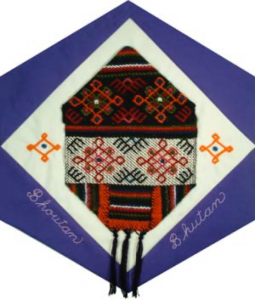Bhutan

The Block
In Bhutan, weaving is an art form, particularly in the eastern high mountain region where women carry out the task in the open air on portable back-strap looms. Eastern Bhutan is renowned for hand-loomed textiles done in the weft-weave technique. The embroidered, coarsely woven, woolen fabric which comprises this block was donated by Jamie Zeppa and is an example of material that would be used for creating saddlebags, wall hangings and floor runners. To help preserve and promote Bhutan’s cultural heritage, a compulsory national dress, made most often from finely woven cotton or silk, was declared in 1989. Men wear the gho (a long robe tied at the waist and pouched over a kera {woven cloth belt to form a pocket) and, on formal occasions, a kabney, a long sash or scarf wrapped around the shoulder and the waist. Women wear the unique kira (an unstitched garment creatively folded around the body and fastened at the shoulder by a distinctive silver or gold coma). The cloth needed to produce a single kira can take up to a full year to complete. In addition to occasionally being used as a form of currency, the texture, colours and decorative embellishments of these garments determine social status and class. For example, only the king and the Je Kenpo (the chief abbot) are to wear the saffron coloured kabney, while the ordinary citizens will wear a white kabney; specific colours all denote specific roles within the Bhutanese society.
Cultural Profile
Nestled in the eastern Himalayas between India and China, Bhutan, one of the few constitutional monarchies left in the world, is an ancient kingdom where Old World values of respect, gratitude and generosity prevail. Although it remains one of the most secluded nations in the world, the majesty of Bhutan’s natural surroundings has for centuries drawn people from all over the globe in their search for spiritual wisdom and inspiration. The Bhutanese refer to themselves as Drukpa people, a name originating from the historical country name of Druk Yul, meaning “land of the thunder dragon.” The official language is Dzongkha, although some 24 dialects with various levels of similarity with Dzongkha still exist as a result of the isolation of villages in the highlands.
Bhutan is modernizing cautiously, ensuring that traditions and a healthy relationship with the natural environment are not lost along the way. Such respect for the natural environment has made Bhutan an ecological haven for various types of plants and animals; over 50 types of rhododendron grow here. It is also home to the snow leopard, blue sheep, and 770 species of birds. The country is often used as a model for preservation of biodiversity as 40% of its territory is protected.
The thirteen traditional arts of Bhutan are well-preserved and formally categorized. They range from gar-zo, the making of bridges using iron chains, to stone building, and paper making to bronze work. One of these is weaving, a source of national pride for the fabrics are seen as the embodiment of Bhutanese identity. It was originally exclusively done by women. Weaving in Bhutan flourished through two channels over the past centuries: it was done in every household to produce fabrics for the everyday use, but also by professional weavers supported by the royal household to produce even more refined pieces. Originally, back-strap looms were used, but horizontal and card looms have been introduced and the three are still used today. The vivid colours are usually obtained with natural dyes.
Other traditional crafts include bamboo carving and weaving to produce stools, mats, baskets, containers for liquid and bows and arrows; embroidery and appliqué to produce boots, clothes or the complex thangkas, religious pieces of painted or appliqué silk representing a Buddhist deity, scene or mandala.
Many public festivals take place in Bhutan, such as the Tshechu, a religious festival held in all the districts of the country at various dates throughout the year. It almost always includes a dance and music performance. The public dances, called the Cham, involve elaborate costumes and masks. Some of the traditional musical instruments include the lingm, a flute, the dramnyen, a seven-string lute, and the chiwang, a type of fiddle.
Most Bhutanese people still live in small rural farming communities in the central uplands and the foothills of the Himalayas. Family values are strong and maintained by deeply held religious beliefs and a well-preserved traditional way of life. The Bhutanese are a friendly people who often give gifts to strangers. It is common to be spontaneously invited for a meal of Ema Datshi a stew of chili pepper and cheese that is the national dish.
The number of Bhutanese in Canada remains extremely small, standing at only 35 in 2001 (No numbers in the census of 2011). The relationship between Bhutan and Canada is developing gradually. Since 1985 Bhutanese teachers have come to further their studies at the University of New Brunswick, while Canadian teachers have traveled to work in Bhutanese schools. In May of 2004 Canada welcomed the first Bhutanese Ambassador to Canada, H.E. Daw Penjo, who is also the head of Bhutan’s permanent mission to the United Nations.
Sponsor: Dr. Catherine Lamarche
